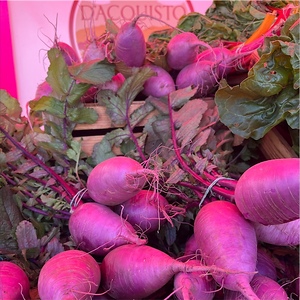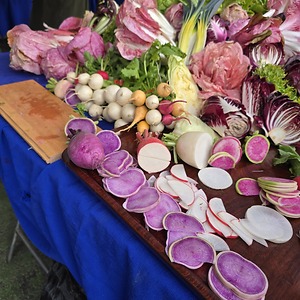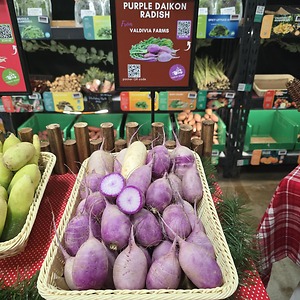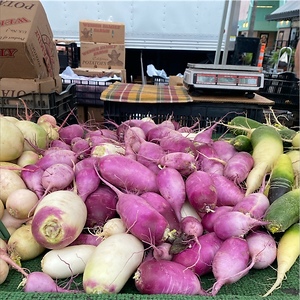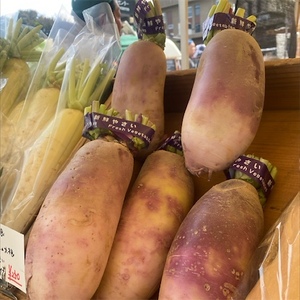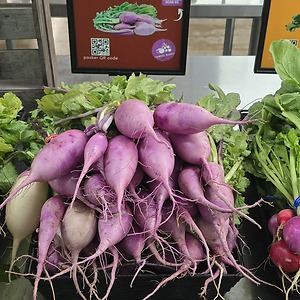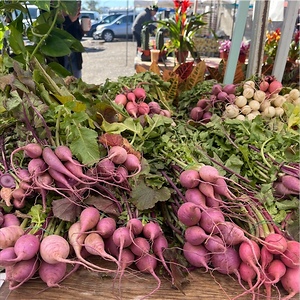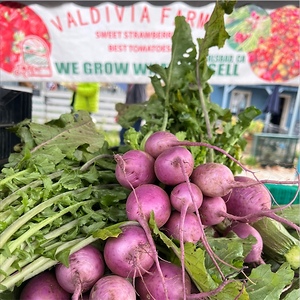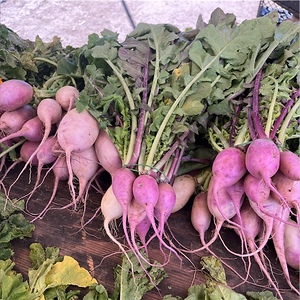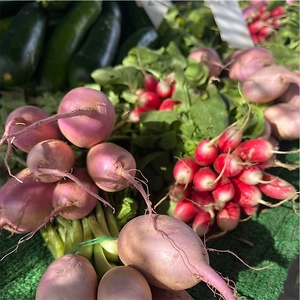

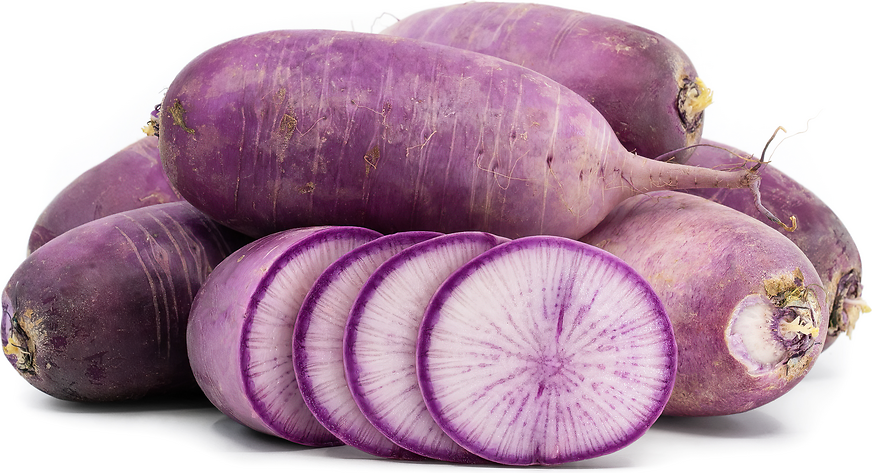
Purple Daikon Radish
Estimated Inventory, bunch : 0
Description/Taste
Purple Daikon radishes are medium to large roots, averaging 15 to 25 centimeters in length, and have an oblong, cylindrical appearance with blunt, curved ends. There are also dwarf varieties that are smaller in size, tapering into a single taproot. The radish’s skin is semi-smooth, textured, and firm, showcasing light purple to violet hues. Underneath the surface, the flesh is dense, crisp, and bi-colored, streaked with purple stripes over a white base. The flesh may also feature a dark purple ring around the edge of the flesh, just below the skin. Purple Daikon radishes contain less water than white daikon varieties and retain a crunchy, snap-like core even when grown to larger sizes. The radish also bears a mild, subtly sweet, and peppery flavor. The sharpness of the root will vary depending on the specific variety and the climate where the radish is grown. Hotter temperatures will produce pungent, spicier roots, while cooler climates will create mild, slightly peppery radishes. Once cooked, the flesh softens to a consistency similar to a potato and develops a neutral flavor. Purple Daikon radishes also grow dark green, serrated leaves that are edible and have a vegetal, peppery taste.
Seasons/Availability
Purple Daikon radishes are available year-round, with a peak season in the winter through spring.
Current Facts
Purple Daikon radishes, botanically classified as Raphanus sativus, are specialty hybrids belonging to the Brassicaceae family. There are many different varieties of violet-hued radishes generally categorized under the Purple Daikon name, and often the roots are simply known as Purple radishes in markets. Purple Daikon radishes contain a milder flavor than white daikon varieties and are highly valued for their striated, colorful flesh. The radishes can be grown year-round, but they are primarily considered a winter or spring vegetable widely used in Chinese, Japanese, Korean, Indian, and Southeast Asian cuisine. Purple Daikon radishes are less common than white daikon cultivars, and when grown in home gardens, specific varietal names are used for the point of sale, including KN-Bravo, Bora King, Sweet Baby F1, and Aji Ichiban Purple.
Nutritional Value
Purple Daikon radishes are an excellent source of vitamin C to boost the immune system, fiber to regulate the digestive tract, and vitamin E to protect the cells against free radical damage. The roots are also a good source of potassium to balance fluid levels, calcium and phosphorus to strengthen bones and teeth, and contain lower amounts of copper, magnesium, iron, and folate. The purple flesh provides anthocyanins, colored pigments that have antioxidant-like properties to reduce inflammation. In traditional Asian medicines, daikon radishes can also be infused into honey and used as a natural throat and cough soother for colds.
Applications
Purple Daikon radishes have a mild, sweet, and peppery flavor well suited for raw, cooked, and pickled preparations. The radishes can be eaten with or without the skin, and when raw, the flesh can be thinly sliced and incorporated into salads, used as a raw vessel for dips, or chopped and mixed into slaws. The brilliant, bi-colored flesh adds visual appeal to sandwiches, appetizer plates, sashimi, and pickled preparations, or it can be coarsely grated using a special Japanese grater as a condiment. The grated daikon is known as daikon oroshi and can be added to sushi, soups, or soba noodle dishes. In addition to raw preparations, Purple Daikon radishes can be sliced into chips and fried, chopped and tossed into curries and stews, sliced and roasted for a caramelized flavor, or stir-fried with vegetables as a main dish. Beyond the roots, Purple Daikon radish leaves are edible and can be tossed into salads, sauteed as a side, or simmered into soups. Purple Daikon radishes pair well with herbs such as dill, parsley, thyme, and mint, carrots, bok choy, cabbage, mushrooms, ginger, green onions, beets, and meats, including beef, pork, duck, poultry, and fish. Whole, uncut Purple Daikon radishes will keep 1 to 2 weeks when wrapped in newspaper or plastic and stored in the refrigerator. Once cooked, the radish pieces will keep 3 to 7 days, and the leaves will keep up to 3 days in the fridge. Purple Daikon radishes can also be blanched and frozen for extended use for up to one month.
Ethnic/Cultural Info
In Korea, Purple Daikon radishes are popularly pickled into kimchi, a traditional dish served as a condiment or side accompaniment to entrees. There are many different variations of kimchi found throughout Korea, utilizing varying ingredients and containing different spice levels. In kkakdugi, a cubed radish kimchi, white daikon radishes are typically used, but Purple Daikon radishes are also used to add vibrant coloring to the monochromatic dish. Radish kimchi provides tangy flavors that can help balance rich, fatty, and savory dishes. The fermented radishes can be served with eggs, stir-fries, rice, and roasted meats, or they can be paired with galbitang, a type of short rib stew. Purple Daikon radishes also contain a lower water content than other daikon varieties, allowing the flesh to readily absorb liquids. The roots can be pickled in vinegar to develop a bright pink hue, or they can be stirred into soups to absorb the broth.
Geography/History
Daikon radishes are believed by experts to be native to the Mediterranean and coastal regions along the Black Sea. The mild roots were introduced to Asia through trade routes in ancient times and were estimated to have arrived in China and Japan sometime before the 4th century. The elongated radishes became widely cultivated throughout Asia and were grown as a long-storing vegetable, utilized in everyday meals, and as a nutrition source during seasons of famine. Over time, new varieties of daikon radishes were created, including Purple Daikon cultivars, and were favored for their mild flavor and unusual coloring. Today Purple Daikon radishes are grown worldwide as a specialty radish, especially in Japan, Korea, China, and the United States. The fresh roots are available through local markets, distributors, and select grocers.
Recipe Ideas
Recipes that include Purple Daikon Radish. One
| Olive Jude |
|
Kohlrabi and Purple Daikon Radish Miso Ginger Slaw |
| Beyond Kimchee |
|
Radish Pancake |
| Food Fidelity |
|
Simple Asian Purple and Green Daikon Radish Salad |



